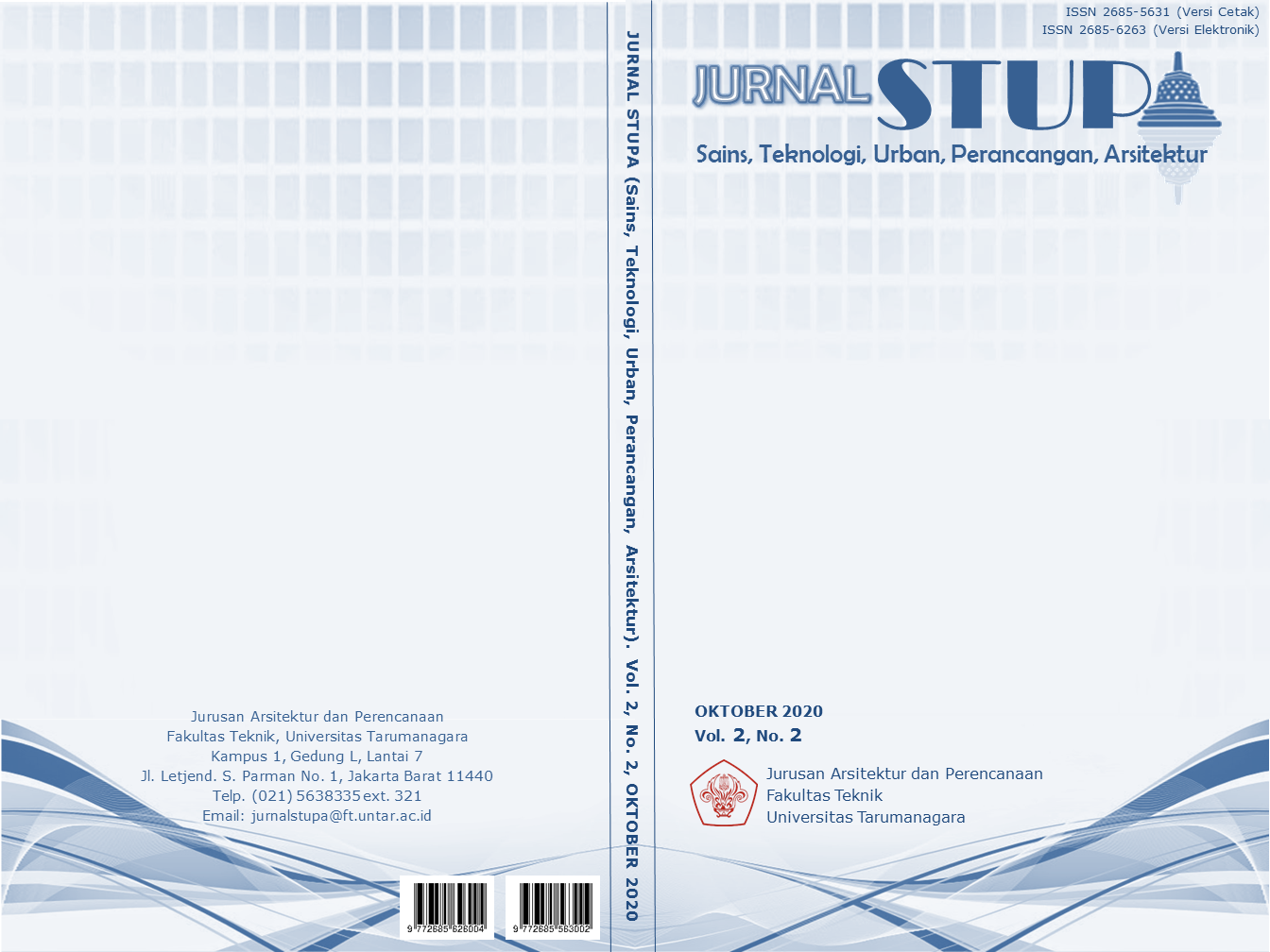PERHENTIAN KULINER JUANDA
Main Article Content
Abstract
Kebon Kelapa sub-district is located in Gambir, Central Jakarta. It is a capital region dominated by offices and commercial buildings. The people there are working as employees and many residents also open small culinary businesses to support surrounding activities. Juanda Station is a catalyst for mobility between the first place and the second place in that area. The location of the site that extends directly facing the station towards neighborhood allow to collect the flow of commuters and provide an opportunity for more exposure to the culinary businesses by the local community of Kebon Kelapa. The chance for a third place as a neutral transit space to gather people in the area. It becomes a meeting point between local community and the station commuters. Through Narrative Architecture (Tshchumi, 1994), Juanda Food Station promote food ingredients and the cycles from production, distribution, cooking process, consumption, and decomposition as unifying activities for the local community and commuter workers passing by every day. The project is also equipped with supporting facilities such as transit hub and playground as bridges between the characters of visitors, allowing permeability from both sides of the site. When the city experiences a process where space and time run independently, humans are no longer experience space due to the demands of high mobility. Cities become merely a place of survival (Armand, 2017). By presenting new space experiences through food as daily primary needs connecting local potential with newcomers, Juanda Food Station becomes an urban kitchen and dining in the middle of the city rush.
Keywords: commuters; food; local community; station
Abstrak
Kelurahan Kebon Kelapa berada di Kecamatan Gambir, Jakarta Pusat, yaitu kawasan jantung ibukota yang didominasi perkantoran dan komersial. Para warga selain bekerja sebagai karyawan juga banyak yang membuka usaha di bidang kuliner sebagai pendukung kegiatan sekitar. Stasiun Juanda menjadi katalis pergerakan antara tempat pertama dan tempat kedua pada kawasan tersebut. Letak tapak yang memanjang, langsung menghadap stasiun dan menembus ke permukiman dapat menangkap arus komuter dan miningkatkan exposure usaha kuliner warga Kebon Kelapa. Peluang tempat ketiga (third place) sebagai ruang singgah netral untuk berkumpulnya para subjek pada kawasan tersebut menjadi titik temu antara warga sekitar dengan komuter stasiun. Melalui metode Narrative Architecture (Tshchumi, 1994), Perhentian Kuliner Juanda mengangkat bahan makanan serta siklusnya mulai dari produksi, distribusi, pematangan, konsumsi, hingga penguraian menjadi kegiatan pemersatu dan berkumpulnya masyarakat sekitar dengan para pekerja komuter yang berlalu-lalang setiap harinya. Kemudian proyek juga dilengkapi fasilitas pendukung seperti transit hub dan playground sebagai jembatan antar pengunjung, sehingga memungkinkan permeabilitas dari kedua sisi tapak. Di kala Kota Jakarta mengalami proses di mana ruang dan waktu berjalan sendiri-sendiri, manusia tidak lagi mengalami ruang akibat tuntutan mobilitas tinggi. Kota menjadi sekedar tempat bertahan hidup (Armand, 2017). Dengan menghadirkan pengalaman dan perasaan baru terhadap ruang melalui pangan sebagai kebutuhan primer sehari-hari menghubungkan potensi lokal dengan pendatang, Perhentian Kuliner Juanda menjadi dapur dan ruang makan kota di tengah kesibukan urban.
Article Details
References
Armand, A. (2017). Arsitektur yang Lain. Jakarta: PT Gramedia Pustaka Utama.
Badan Pusat Statistik Provinsi DKI Jakarta. (2019). Provinsi DKI Jakarta Dalam Angka 2018. Jakarta: Badan Pusat Statistik Provinsi DKI Jakarta
Fujimoto, S. (2008) Primitive Future. Inax
Jormakka, K. (2008). Basics Design Methods. Massachusetts: Birkhäuser Boston
Norberg-Schulz, C. (1968). Intentions in Architecture. Massachusetts: The MIT Press.
Oldenburg, R. (1989). The Great Good Place. Massachusetts: Da Capo Press
Project for Public Spaces, diakses 20 Januari 2020, www.pps.org
Survei Business-to-Business (B2B) online expert 2016
The 2017 Global Least & Most Stressful Cities Ranking. Retrieved February 10, 2020, from https://www.zipjet.co.uk/2017-stressful-cities-ranking.
Tschumi, B. (1994). Architecture and Disjunction. Massachusetts: The MIT Press.
United Nation. (2015). Transforming Our World: The 2030 Agenda for Sustainable Development. Retrieved February 17, 2020, from www.sustainabledevelopment.un.org
Zumthor, P (1998) Thinking Architecture. Birkhauser


